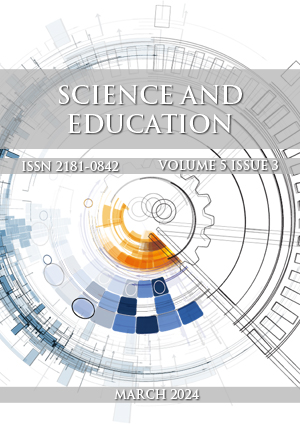The relationship between Afghan EFL teachers’ job satisfaction and organizational commitment with their continuing professional development
Keywords:
job satisfaction, organizational commitment, continuing professional development, EFL, teacherAbstract
Job satisfaction and organizational commitment closely relate to teacher development. In the same way, professional development includes the activities that a teacher contracts either singly or cooperatively toward development after beginning professional practice. These variables all move teachers toward development in the teaching career. The purpose of this study is to investigate the relationship between Afghan EFL teachers’ job satisfaction and organizational commitment to their continuing professional development. To this end, 110 EFL teachers selected from different public schools and private English language institutes in Herat. The participants completed three questionnaires of Job satisfaction, Organizational Commitment, and Continuing Professional Development. The research employed a correlational design. The study helps the policy makers to make faculty committed to the organization to enhance their teaching effectiveness, improve professional practices, and in turn reduce turnover.
References
Adey, P. (2004). The professional development of teachers: practice and theory. Kluwer Academic Publishers. Boston, MA.
Afe, J.O. (2001). Reflection on Becoming a Teacher and the challenges of Teacher Education Inaugural Lectures Series 64, University of Benin, Nigeria.
Al-Alawiyat, A. (2010). Training as motivational tool for the job satisfaction in Saudi Arabia. Unpublished MBA Long Essay.
Allinder, R. M. (1994). The relationship between efficacy and the instructional practices of special education teachers and consultants. Teacher Education and Special education, 17, 86-95.
Anne, M., & Grønholdt, L. (2001). Using employee satisfaction measurement to improve people management: An adaptation of Kano’s quality types. Total quality management, 12(7-8), 949-957.
Bell, B., & Gilbert, J. (2005). Teacher development: A model from science education. Routledge.
Cohen, J. (1988). Statistical power analysis for the behavioral sciences (2nd ed.). Hillsdale, NJ: Erlbaum.
Currivan, D. B. (1999). The causal order of job satisfaction and organizational commitment in models of employee turnover. Human resource management review, 9(4), 495-524.
Dannetta, V. (2002). What factors influence a teacher’s commitment to student learning? Leadership and Policy in Schools, 1(2), 144-171.
Dannetta, V. (2002). What factors influence a teacher’s commitment to student learning? Leadership and Policy in Schools, 1(2), 144-171.
Day, C., & Sachs, J. (2004). Professionalism, performativity and empowerment: Discourses in the politics, policies and purposes of continuing professional development. International handbook on the continuing professional development of teachers, 3, 32.
Edelfelt, R. A., & Lawrence, G. (1975). Inservice education: The state of the art.
Filak, V. F., & Sheldon, K. M. (2008). Teacher support, student motivation, student need satisfaction, and college teacher course evaluations: Testing a sequential path model. Educational Psychology, 28(6), 711-724.
Fullan, M., & Hargreaves, A. (2016). Bringing the profession back in. Learning Forward, Oxford, OH.
Getahun, T., Tefera, B.F., & Burichew, A.B. (2016) Teacher’s Job Satisfaction and Its Relationship with Organizational Commitment in Ethiopian Primary Schools: Primary Schools. European Scientific Journal, 12, 13.
Hargreaves, A., & Goodson, I. (2002). Teachers’ professional lives: Aspirations and actualities. In Teachers’ professional lives (pp. 9-35). Routledge.
Joffres, M. R., & LaPorte, R. E. (1998). Bringing epidemiology manuals and books onto the Internet through the Epilink. American journal of epidemiology, 147(4), 325-329.
Li, M., & Yu, Z. (2022). Teachers’ Satisfaction, Role, and Digital Literacy during the COVID-19 Pandemic. Sustainability, 14(3), 1121.
Mackay, M. (2017). Professional development is seen as employment capital. Professional Development in Education, 43(1), 140-155.
Malik, M.E., Nawab, S., Naeem, B., & Danish, R.Q. (2010). Job Satisfaction and Organizational Commitment of University Teachers in Public Sector of Pakistan. International journal of business and management, 6.
Miskel, C., & Ogawa, R. (1988). Work motivation, Job satisfaction, and Climate. In N. Boyan (ed.) Handbook of Educational Administration. Longman.
Ololube, N. P. (2006). Teachers job satisfaction and motivation for school effectiveness: An assessment. Essays in Education, 18(1), 9.
Parmigiani, D., Jones, S. L., Kunnari, I., & Nicchia, E. (2022). Global competence and teacher education programs. A European perspective. Cogent Education, 9(1), 2022996.
Rastegar, M., Moradi, S. (2016). On the Relationship between EFL Teachers’ Job Satisfaction, Self-Efficacy, and Their Spiritual Sense of Well-Being. Open Journal of Modern Linguistics, 6, 1-12.
Raza, S. A., & Ahmed, N. (2017). Measuring Employees’ Commitment through Job Satisfaction: Perception of Public Primary School Teachers. Bulletin of Education and Research, 39(1), 129-144.



